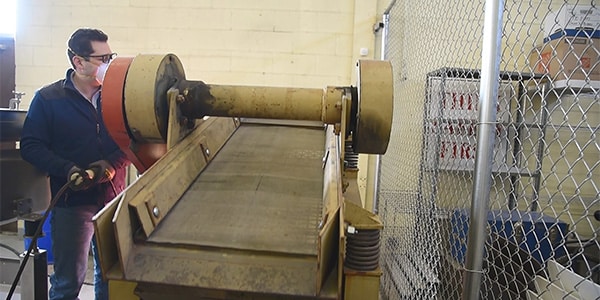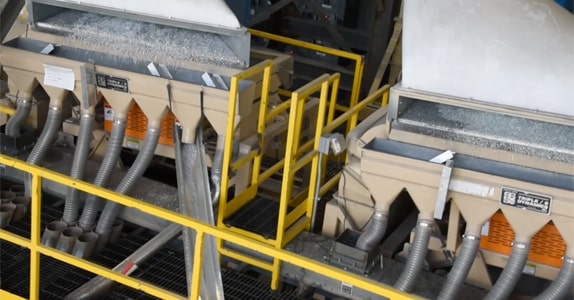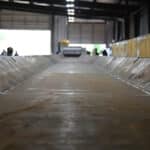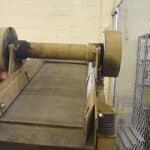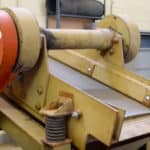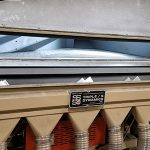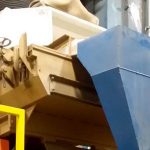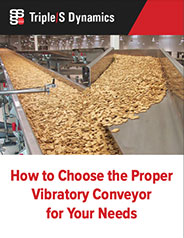Chemical Engineering: Facts At Your Fingertips
Dry, granular solids can be conveyed in a number of ways. Two common devices for transporting granular solids are the angular-pitch vibrating conveyor and the horizontal differential-motion conveyor. The variability in the design and performance between the two types stems from the differences in the kind of motion required to move the mass in one direction. The most significant difference between the two solids-conveying systems is the presence, or absence, of motion in the plane normal (perpendicular) to the plane of the conveying surface.
Angular-pitch vibrating conveyor
In its simplest form, the angular-pitch vibrating conveyor consists of a trough with a mechanism to oscillate it. This type of conveyor can typically be either a “brute-force” type or the natural-frequency type. The majority of angular-pitch vibrating conveyors require vibration isolation to prevent imparting unwanted vibrations to the surrounding support structure. The typical operational frequencies of these conveyors are from 5 to 60 Hz, with common pitch angles from 10 to 45 deg. Typical pitch display cements can range from 0.03125 to 1.5 in.
A brute-force type vibrating conveyor is one that relies strictly on importing a force to a mass to achieve an intended displacement. These are the least energy-efficient of the vibrating conveyors, but generally have a lower initial cost. This type of conveyor allows for speed (flow) adjustment during operation. Brute-force style conveyors must be isolated from the surrounding structure and are generally shorter in length than other types.
The natural-frequency type vibrating conveyor utilizes the resonance frequency characteristics of a spring system to reduce power requirements, as well as the forces required to be introduced into the system to operate. These are the most energy-efficient of the angular pitch vibrating conveyors. These types of conveyors can be either unbalanced (earth-anchored), frame-balanced (requires isolation from surrounding structure) or dynamically balanced (utilizing an equal opposing moss).
Natural-frequency vibrating conveyors employ a simple harmonic motion (that is, sinusoidal) directed along a line that slopes upward in the direction of travel. This line is called the line of action (Figure I). This type of conveying action will stratify the particle sizes being conveyed, which makes them a good resource for screening out oversized and undersized particles from the conveyed material. The pitching action of these types of conveyors, however, can degrade fragile products.
Horizontal-differential motion conveyors
With horizontal differential-motion conveyors, the differential-velocity motion (having different mean velocities and peak accelerations through each half of a cycle) can, through differential friction, cause movement of the mass or object in the direction of the lower mean velocity of the conveyor trough. The line of action may be parallel to the conveying surface, the mass will slide along the surface in a series of sequences, as shown in Figure 2.
The horizontal differential-motion conveyor does not agitate or damage the product being conveyed. The horizontal linear motion of this type of conveyor will not mix or stratify the conveyed materials. Even though it is a friction-dependent type of conveyor, scuffing or marring of the materials is generally not observed over long conveying runs. These conveyors are known for their “gentle handling” characteristics.
Horizontal differential-motion conveyors do not rely on system resonance or frame-mounted reaction forces to operate. Operational frequencies generally fall in to the 2.5 to 6 Hz operating range with displacements of 0.75 to 3.0 in., depending upon the application. Frequencies can be adjusted during operation to control the conveying velocity.
Horizontal differential-mot ion conveying systems are generally suspended using a pendulum-type support system (either above or inverted below the conveyor trough). Supports can be placed up to 20 ft apart and the conveying troughs can be in excess of 200 ft long. Inertial force generators (drives) can typically be placed at either end, above or below the conveying trough and can convey either uni-directionally or bi-directionally. These attributes make this type of conveying method very cost-effective for longer distances.
Determining conveyor type
The following is a set of questions that can help determine the best conveyor type for a specific product application:
- Is your product fragile, coated, dusty or agglomerated?→ horizontal motion
- Are you moving product at a high travel rate? →natural frequency
- What is the conveying length (over 30-ft long)? → horizontal motion
- Do you need to convey uphill (0 to 5 deg)? → natural frequency
- Are wide temperature differences expected? → horizontal motion
- Is your product wet or sticky? →natural frequency
- Do you have heavy surges in your product flow? → horizontal motion
- Do you need to screen the product? →natural frequency
- Do you have restricted space for the material pan? →horizontal motion
- Are sanitation issues important to you? →horizontal motion
- Do you need frequent start-stops? →natural frequency
- Is pan wear and noise a concern? → horizontal motion
- Are wide-ranging variable speed or reversing modes needed? →horizontal motion
- Do you need to spread your product to uniformly feed a dryer or cooler? →natural frequency


